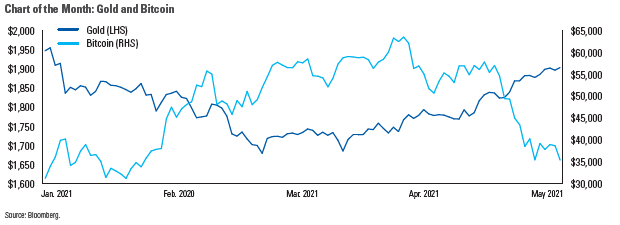Monthly Market Snapshot June 2021

Monthly Overview
Canada’s main stock market index reached record highs in May, with investor sentiment heightened by strong economic data and an improved growth outlook as COVID-19 vaccinations accelerated across the country. Meanwhile, other equity markets were constrained by lingering inflation concerns and surges in virus cases in various parts of the world. Since the start of the year through the end of May, Canada’s benchmark S&P/TSX Composite Index was up over 13%, outpacing the other major equity benchmarks we follow, buoyed by huge improvements in financials, materials and energy stocks, which collectively make up more than half of the index.
Canadian stocks ended May up 3.3%, with eight of the 11 underlying sectors producing gains during the month. Materials, financials and consumer staples led the way with respective gains of 7.8%, 4.3% and 4.3%. Energy stocks had a solid month, climbing 3.9%. The healthcare sector saw the biggest drop for the period, falling 3.5%. Canadian small-cap stocks, as measured by S&P/TSX Small Cap Index, gained 4.1% for a second consecutive month.
The loonie was 1.9% higher versus the greenback in May, reaching a six-year high to close out the month. This dampened returns for foreign equity markets from a Canadian investor’s standpoint. Note that all returns in this paragraph are in Canadian dollar terms. U.S.-based stocks, as measured by the S&P 500 Index, fell 1.1% during the period, driven by challenges out of the consumer discretionary and utilities sectors, which saw respective declines of 5.5% and 4.4%. Information technology, which represents more than a quarter of the U.S. benchmark, fell 2.7% during the month. International stocks, as measured by the MSCI EAFE Index, added 1.1% in May, while emerging markets stocks gained 0.3%.
The investment grade fixed income indices we follow were higher in May, as long-term government bond yields remained steady after surging earlier in the year. Canadian investment grade bonds, as measured by the FTSE Canada Universe Bond Index, added 0.6% during the month, while the key global investment grade bond benchmark increased by 0.9%. Global high-yield issues advanced 0.2%.
Commodities across the board posted positive returns for a second consecutive month. The price of crude oil climbed 4.3% during the month, while natural gas advanced 1.9%. Gold and silver prices were up 7.6% and 8.4%, respectively.
Canadian gross domestic product rose at an annualized rate of 5.6% in the first quarter of 2021, with GDP rising 1.1% month-over-month in March. Inflation in Canada picked up in April, as Canadian consumer prices rose 3.4% year-over-year. Canadian employment decreased by 207,100 in April, as the nation’s unemployment rate rose to 8.1%.
U.S. GDP expanded at an annualized rate of 6.4% in the first quarter. U.S. nonfarm payrolls increased by 266,000 in April, as the unemployment rate rose to 6.1%. The consumer price index rose 0.8% month-over-month in April, while the annual inflation figure climbed 4.2% from a year earlier. One of the main reasons for the surge is that inflation was extremely low at the same time last year, while the U.S. economy was in the midst of a widespread shutdown.
The price of bitcoin tumbled roughly 37% in May as regulatory crackdowns in China and a tweet from Tesla chief Elon Musk announcing his company would no longer accept bitcoin payments were just some of the notable factors that led to the selloff. Higher-than-expected inflation numbers may have also put a dent in the cryptocurrency’s price, as some investors may be doubting bitcoin’s effectiveness as a hedge against reduced purchasing power. Some of these investors might move to gold, which has been steadily climbing since the beginning of April, up just over 10%, and which is traditionally viewed as being a hedge against inflation.

Posted In: PostsMarket Updates